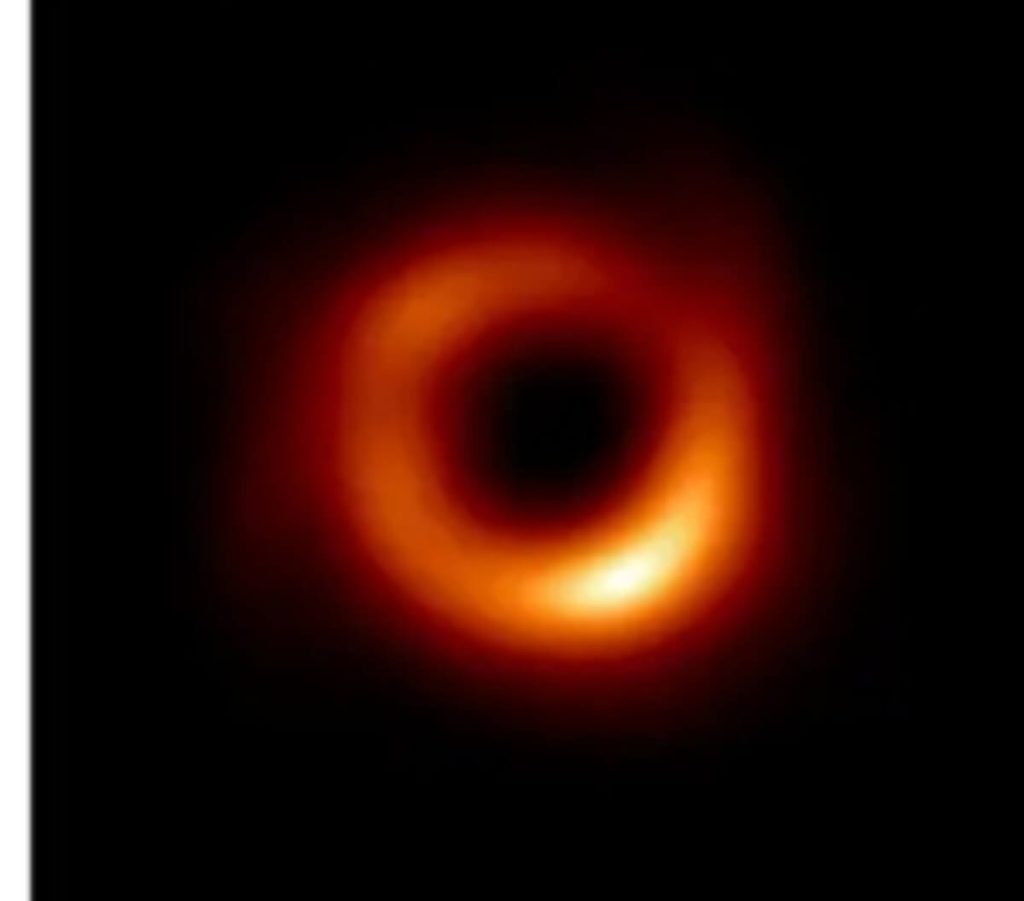

Simulated images of M87* at 345 GHz (Credit: EHT, D. Pesce, A. Chael)
CAMBRIDGE, Mass. — When exploring outer space, the sharpness of our vision has always been limited by Earth’s atmosphere and the physical size of our telescopes. But astronomers shattered these limitations in 2024 by achieving the highest-resolution observations ever made from our planet’s surface.
Through an innovative technique that transforms multiple telescopes across the globe into one enormous virtual observatory, researchers detected light from distant galaxies at high frequencies to create images so precise it’s like being able to read the fine print on a business card in Los Angeles while standing in New York. The breakthrough promises to reveal unprecedented details about some of the universe’s most mysterious objects, including the environments around supermassive black holes.
The study, published in The Astronomical Journal, reveals the highest-resolution images ever captured from Earth’s surface by detecting light from distant galaxies at a frequency of around 345 GHz on the Event Horizon Telescope (EHT). A team of international researchers has successfully conducted the first very long baseline interferometry (VLBI) observations at an unprecedented wavelength of 870 micrometers, opening new possibilities for studying black holes and other cosmic phenomena in extraordinary detail.
What is the Event Horizon Telescope?
The Event Horizon Telescope (EHT) is a planet-wide network of radio observatories working together as one virtual Earth-sized telescope. Rather than building a single massive observatory, scientists combine data from multiple telescopes across the globe to achieve ultra-high-resolution views of distant objects. This innovative approach made history in 2019 when it captured the first-ever image of a black hole, and now, with its new high-frequency capabilities, the EHT can see space with unprecedented clarity.
The technology allows astronomers to see things in space at an incredibly fine level of detail of approximately 19 microarcseconds, which is roughly comparable to seeing a grain of sand in Miami from Seattle.
“At 345 GHz, our images will be sharper and more detailed, which in turn will likely reveal new properties, both those that were previously predicted and maybe some that weren’t,” says study co-author Alexander Raymond, a postdoctoral scholar at NASA’s Jet Propulsion Laboratory, in a statement.
The technique works by combining data from multiple telescopes spread across vast distances, effectively creating a virtual telescope as large as the distance between the farthest participating observatories. To achieve higher-resolution images, astronomers can either increase the distance between radio dishes or observe at a higher frequency. Since the network was already Earth-sized, the team focused on expanding its frequency range.


EHT, D. Pesce, A. Chael)
“To understand why this is a breakthrough, consider the burst of extra detail you get when going from black and white photos to color,” explains Sheperd Doeleman, Founding Director of the Event Horizon Telescope. “This new ‘color vision’ allows us to tease apart the effects of Einstein’s gravity from the hot gas and magnetic fields that feed the black holes and launch powerful jets that stream over galactic distances.”
The EHT famously captured the first-ever image of a black hole in 2019. While Einstein’s theory predicts that the size of black hole rings should appear similar at both 230 GHz and 345 GHz frequencies, the hot gas swirling around these cosmic objects will look different at these frequencies, providing new insights into their behavior.
The research faced some big challenges. Water vapor in Earth’s atmosphere blocks more of the signals at 345 GHz compared to 230 GHz, making it harder to detect black holes. To solve this, the team upgraded their equipment to pick up weaker signals and carefully chose times with clear, dry weather for their observations.


EHT, D. Pesce, A. Chael)
The test observations only used part of the EHT network, with telescopes in Chile, Spain, France, Hawaii, and Greenland. These high-altitude locations were chosen because they have clearer skies and more stable conditions for observing space. However, the weather can be extreme. On Maunakea in Hawaii, for example, researchers had to drive on icy roads after a snowstorm to get the telescope running in calm weather.
This test was just the beginning of exciting new advancements in black hole research. The next phase of the EHT project will add more telescopes in key spots and upgrade the current ones to work at multiple frequencies between 100 GHz and 345 GHz. These upgrades could make the network 10 times better at collecting and analyzing data, leading to even sharper and more detailed images of black holes.
The enhanced capabilities could help create time-lapse movies of black hole environments and provide unprecedented views of these extreme objects. Multiple frequency observations will also help distinguish between the effects of Einstein’s gravity and the behavior of hot gas and magnetic fields around black holes, potentially revealing new insights about how these cosmic objects influence their surroundings.
Paper Summary
Methodology
The research team used a technique called very long baseline interferometry at a frequency of 345 GHz (wavelength of 870 micrometers). This involved coordinating observations across multiple high-altitude telescopes in Chile, Hawaii, Spain, France, and Greenland. The telescopes simultaneously observed common astronomical sources, with their data later combined through sophisticated computer processing. To overcome atmospheric challenges, particularly the increased absorption of radio waves by water vapor at higher frequencies, the team increased their instrumentation bandwidth and carefully timed observations to coincide with optimal weather conditions at all sites.
Results
The team successfully detected signals from multiple sources on intercontinental baselines, achieving angular resolutions as fine as 19 microarcseconds. They found that the stability and coherence of the signals at 345 GHz were comparable to observations at lower frequencies, despite the increased atmospheric challenges. Notably, the observations aligned with Einstein’s predictions that gravity bends all wavelengths of light similarly – meaning the size of black hole rings should appear consistent at both 230 GHz and 345 GHz frequencies, while the surrounding hot gas appears different at these frequencies.
Limitations
Weather conditions significantly impacted observations, with atmospheric opacity being 3-3.5 times higher at 345 GHz compared to longer wavelengths. Water vapor in Earth’s atmosphere posed a particular challenge, absorbing more signal at higher frequencies. Technical challenges included lower receiver sensitivity and reduced aperture efficiency at higher frequencies. Some participating telescopes experienced operational issues during the test period, and observations required precise timing to catch optimal weather conditions at all sites simultaneously.
Takeaways and Discussion
This breakthrough demonstrates the feasibility of VLBI observations at 345 GHz, opening new possibilities for studying black holes and other celestial objects. The success suggests that future observations could provide not only sharper images but also multi-frequency views that help distinguish between gravitational effects and the behavior of hot gas around black holes. The technique’s success paves the way for the next-generation Event Horizon Telescope, which aims to increase imaging data capacity by a factor of 10 through new antennas and multi-frequency capabilities.
Funding and Disclosures
The research was supported by numerous institutions and funding bodies, including the National Science Foundation, the Gordon and Betty Moore Foundation, and various international research organizations. The project involved collaboration among multiple observatories and research facilities worldwide, including the Center for Astrophysics | Harvard & Smithsonian and the Smithsonian Astrophysical Observatory.
Publication Information
This research was published in The Astronomical Journal (Volume 168, Issue 130, September 2024). The paper, “First Very Long Baseline Interferometry Detections at 870μm,” was led by Alexander W. Raymond, who conducted the research while at the Center for Astrophysics | Harvard & Smithsonian before moving to NASA’s Jet Propulsion Laboratory. The study includes contributions from numerous researchers at institutions around the world.








